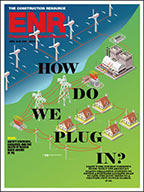This has been a strong year for wind-power capacity increases, but some experts are worried about the industry's future. They point to increased industry layoffs and plant shutdowns as well as the impending expiration of the renewable energy production tax credit (PTC) as evidence that as early as next year the market may weaken.

Even so, the U.S. ranked as one of the world's largest and fastest-growing wind markets last year, with wind power representing 32% of all new electric capacity additions nationwide and accounting for $14 billion in new investment, according to a U.S. Dept. of Energy report released on Aug. 14.
First-quarter 2012 was the second most-active quarter for wind power construction projects, with 1,695 megawatts (MW) of capacity installed, according to trade group American Wind Energy Association (AWEA), Washington. This is up 52%, compared with the same year-ago period although below unspecified levels in second quarter 2008, AWEA says.
First-quarter installations brought the country’s total installed capacity to 48,611 MW, and more than 8,000 MW are currently under construction in 31 states and in Puerto Rico, AWEA says. States with the highest amount of installed capacity are California, with 370 MW installed, followed by Oregon (308 MW), Texas (254 MW), Washington (127 MW) and Pennsylvania (121 MW). AWEA says that 38 states now have utility-scale installations and 14 of those have installed more than 1,000 MW.
In the tristate region, many projects have been proposed and scrapped in recent years. But those that appear to be close to moving ahead include the Allegany Wind Farm, a 72.5-MW, 29-turbine project that owner-builder EverPower Wind Holdings, Inc., New York, plans to build across 5,000 acres in Allegany, N.Y. While the $118-million project was proposed years ago and still faces strong community opposition, officials say it may start construction as early as next year.
However, that news comes as domestic wind industry jobs continue to be slashed and as firms consolidate. In the tristate region, recent activity includes Hartford-based United Technologies Corp.'s (UTC) sale of its Clipper Windpower unit to Los Angeles-based private equity firm Platinum Equity. UTC says it sold this and other units earlier this year to help finance its acquisition of Goodrich Corp. But Gregory Hayes, CFO of UTC, told investors last March that there has been no increased push in recent years for renewable energy in the U.S.
More recently, Otter Tail Corp. (OTC) announced it is in negotiations with an unspecified potential buyer for all assets of its tower manufacturer DMI Industries. Should those talks fail, however, OTC plans to sell DMI’s fixed assets after DMI works off its 2012 backlog and to shutter DMI’s Tulsa, Okla., plant with the loss of 167 jobs, and its West Fargo, N.D., facility, which has 216 workers.
“The wind industry’s present economics, substantially driven by the absence of a production tax credit renewal by the U.S. Congress, the lack of a predictable national energy policy, and by low natural gas prices, has contributed to a dramatic decline in the demand for wind towers,” OTC said in an Aug. 6 statement. “This market circumstance is untenable to Otter Tail Corporation.”
In May, wind power equipment producer NRG Systems, Hinesburg, VT, slashed 18 jobs at its Hinesburg facility, citing "ongoing uncertainty and volatility in the global wind energy industry."
Wind power supporters say that jobs cuts and consolidations underscore the need for the federal PTC to be extended.



